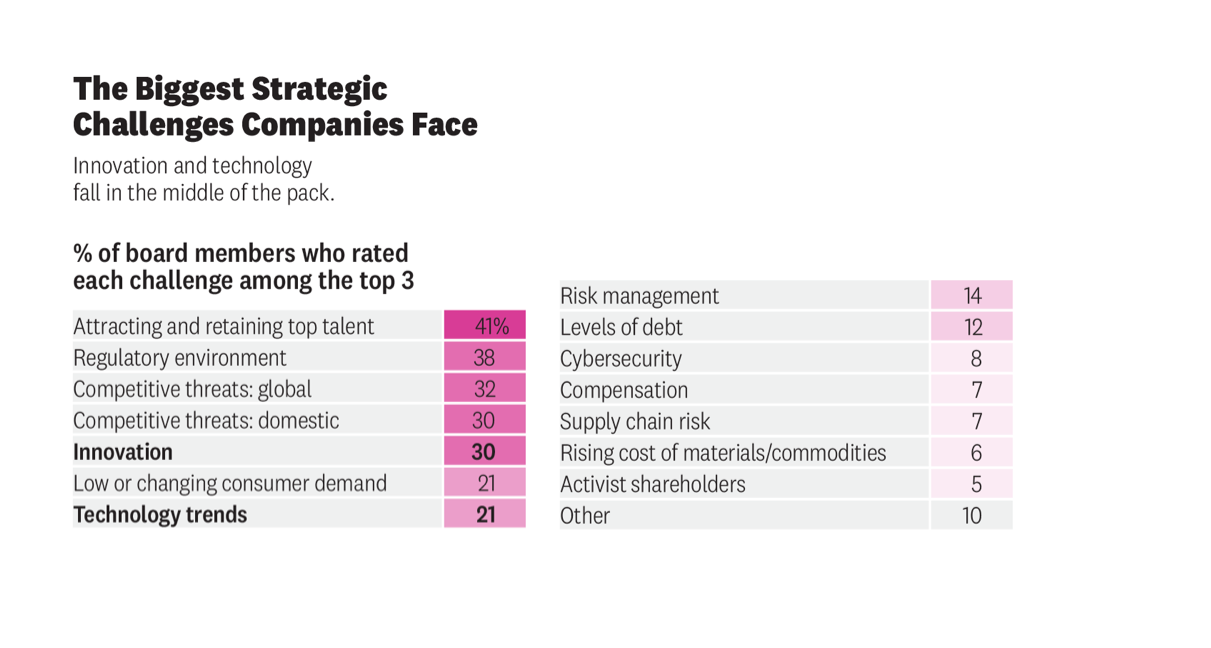Why top managers struggle to put innovation in their agenda?
Any top managers of big enterprises will tell you that innovation matters, and that innovation has always been of the top strategic priorities for their organization. However, a research by KPMG has shown that only 20% of CEOs confirmed that innovation is at the top of their personal agenda. Are top managers lying? Who is responsible for this misalignment? If innovation is believed to be the major driving force for their business, why are top managers struggling to put innovation in their own agenda? Innovation, as much as organizations and top managers themselves wish, often stay only on the table in the board room. In the same research, only 38% of top managers believed that their organization was adapted to foster innovation and only 28% confirmed that innovation was actually a priority at both strategic and operational levels.
Complex symptoms, simple causes
A mindset problem
A research published on Harvard Business Review shows that to most top managers, innovation falls behind other strategic challenges, such as:
attracting and retaining top talent (41%)
dealing with changing the regulatory environment (38%)
dealing with global competitive threats (32%)
dealing with domestic competitive threats (30%)

Innovation comes after these recurring issues, landing at 30%.
The reason for this presumably comes from the fact that the majority of managers are executors. They have been intensively trained to process immediate results for rapid and sustainable growth (mostly in terms of financial performance). Innovation, on the other hand, might take a long time from being ideas to concrete fruition. This opposes directly to those short-term requirements. So even if managers understand the importance of innovation, nobody got the time to wait for years. This means no proper time and resource allocations for innovation activities. In some cases, managers might fear that innovation will directly harm their current business. Everyone wants to disrupt their competitors, but when the risk of innovation is to disrupt their own business, many will hesitate.
At Stim, we have discussed with several innovation directors who stalled the investment in some breakthrough innovation projects just because the new offers will directly affect their current ones. The rationale, again, is based on the favour of the current ROI: this new offer will disrupt our current business, so we should not invest a lot in it. But the point is if your firm does not do anything to develop this particular technology or deploy this new business model, your competitors will step ahead and do it for you. Living in denial to hide away from your fears won’t help. And slowing down the investment on major innovation projects won’t either.
A skillset problem
One thing is for sure: executors will have a different skill set than that of innovators or entrepreneurs. The conventional methodologies for continuous improvements and optimization are just not opted for the requirements of innovation activities. An executor is excellent in reinforcing the existing processes or making marginal or incremental changes to existing offers; but might feel unequipped when facing innovation decisions that require a good leap of faith, mindset and methodology.
Yes, you didn’t read it wrong. Unlike the common opinion that innovation requires messy experiments instead of methodical analysis, at Stim, we believe that innovation management can be methodized, structured and optimized. If executors keep on looking at and treating innovation activities the same way they have dealt with conventional challenges of their business, the innovation performance will not be correctly assessed. Applying the same set of success criteria of traditional activities to innovation activities will not only devaluate the firm’s innovation efforts but also prevent systematic leverage of new capabilities. Both of these problems, in the long run, will put innovation activities out of the strategic focus. The inevitable outcome is that firms will be behind the other competitors in the race for new capability accumulation, and might miss the next big revolution in their industry.
The solution?
Top managers must be, and of course, can be trained with innovation management skills and mindset. This shift of mindset and skillset will require the right tools to make strategic innovation decisions, including:
Ambition: why are we doing this? what purpose are we aiming at?
Organisation: what are internal organization and processes that can foster it? how to level up the ambition of our team and their ideas?
Resources: which level of investment should we put into this project? do we have the right amount of resources to realise this? (in terms of technology and talent etc.)
The starting point for top managers – the well-trained executors – is to understand that the gap between their perception of innovation(it is crucial to their company’s future) and the reality (time & resources are not allocated sufficiently for innovation) can be filled up. The next step is to learn how to fill up this gap.
Despite your efforts, your innovation performance is still falling short?
You might need to build a powerful innovation machine! Download our (free) guide here!

